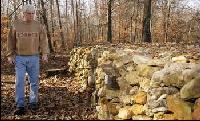

The boat reaches a little cove. It is the place where members of her family were murdered. It is here that she disembarks and finds a large mound surrounded by stones with a much smaller mound nearby.
She knows someone has buried her family.
The next day, Te-lah-nay takes stones from the river's edge and adds them around the mounds. It is her way of honoring her ancestors.
Her great-great-grandson, Tom Hendrix, now walks along the path of another stone wall, this one surrounding his property in Lauderdale County. It is here that he honors Te-lah-nay.
"It's two and a half miles of stone," Hendrix said. "It is the longest unmortared stone wall known in the U.S. and the only one ... with a prayer circle east of the Mississippi River.
"There is a stone from every state in the United States and 126 stones from other countries, territories and islands."
The wall, as it stands, took Hendrix more than 15 years to build. It is never finished, he says. Its meandering shape is indicative of Te-lah-nay's travels.
"She did not make an ordinary journey. I did not build an ordinary wall," Hendrix said. The wall and the prayer circle within, draws a near constant stream of visitors from all over the world, including members of other Indian nations, Hendrix said.
Many bring stones from their land to add to the wall.
Hendrix is following his great-great-grandmother's example in ensuring that the legacy of his family will not die. Te-lah-nay passed on to her offspring 12 stories of the Yuchi people and the story of how she returned to Lauderdale County. Hendrix's grandmother began teaching him the stories when he was a boy.
It was October, during the aftermath of a time when American Indians were forcibly removed from the eastern United States and forced to go to Oklahoma. Though the Indian Removal Act of 1830 targeted many Cherokee Indians, in the end, members of the Choctaw, Chickasaw, Creek and Seminole nations suffered the same fate.
They all were forced from their homes by federal troops, rounded up and sequestered in camps where conditions were so bad, many died. The survivors were forced to make the long trek to reservations in the west, most on foot. Thousands died during the journey.
Some Indians scattered, escaping detection. For a time, that was the fate of Te-lah-nay, the young girl who, with her sister, Whanna-le, dodged death by the quick actions of their grandmother. They were placed in a canoe and sent downstream. Te-lah-nay believes it was her grandmother who buried the others.
Te-lah-nay and her sister were discovered during the mopping up operation after the initial roundup of American Indians. Soldiers and local constables found small pockets of Indians who had been overlooked during the initial journey and sent them, too, on the walk to Oklahoma.
"(The two sisters) found an old abandoned house and hid in the root cellar," Hendrix said. "They were found there and numbered. My great-great-grandmother was number 59; her sister was number 60. The soldiers didn't know what tribe they were with, so they were placed with the Creek people."
Te-lah-nay spent several months at the camp in Oklahoma.
"She believed she would die if she remained," Hendrix said. Te-lah-nay, like all the American Indians from the Tennessee Valley believed there was a woman in the river who sang to them. Te-lah-nay and the river were sisters.
Hendrix, in his best storytelling voice, recounts Te-lah-nay's reasons for making the desperate journey back to her home and the river.
"When I was born, my grandmother took my birth cord and put it in the river and that made the river my sister," Hendrix said, speaking for his ancestor. Also, Te-lah-nay had a recurring dream of her grandmother beckoning her back home.
"When I got to the nation (in Oklahoma), I listened to the river and there were no songs. I knew then, I would die."
One spring morning, the young Indian girl slipped away from the Oklahoma camp. It took her two years, but she walked back to Lauderdale County and was adopted by a white woman by the name of Ferguson. Ferguson gave her the white name, Mary, in order to have Te-lah-nay recorded in the census. Te-lah-nay settled near Little Cypress Creek with her husband, Jonathan Levi Hipp.
"Almost immediately, she started practicing her medicine," Hendrix said. Unlike other tribes, the women are the healers among the Yuchi people.
Hendrix has some of his great-great-grandmother's letters, precious words written in her own hand.
Some of the words are in Yuchi language, something that is significant because there are very few descendants remaining who speak and read the Yuchi language.
Hendrix is determined to preserve and to share the story of his ancestors. He has authored a book, "If the Legends Fade," which he sells on his Web site, www.ifthelegendsfade.com. Proceeds from the book are used to help American Indians, he said.
Hendrix knows of the importance of the Yuchi who still live in Oklahoma. He visited one elderly Yuchi woman years ago to learn the meaning of the Yuchi words written by Te-lah-nay.
It was here that he also learned the meaning behind his ancestor's name.
"I almost fell off the porch when she told me," Hendrix said. "I had always heard she had unusual eyes.
"`Ah, Te-lah-nay,' the woman said. `The one with the dancing eyes.'"
Story from: Times Daily
February 17, 2003
Neverending legacy
By Sherhonda Allen
Night Editor